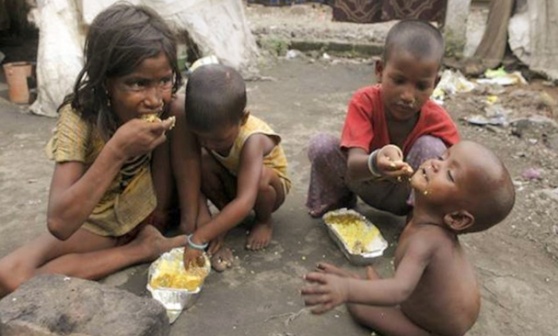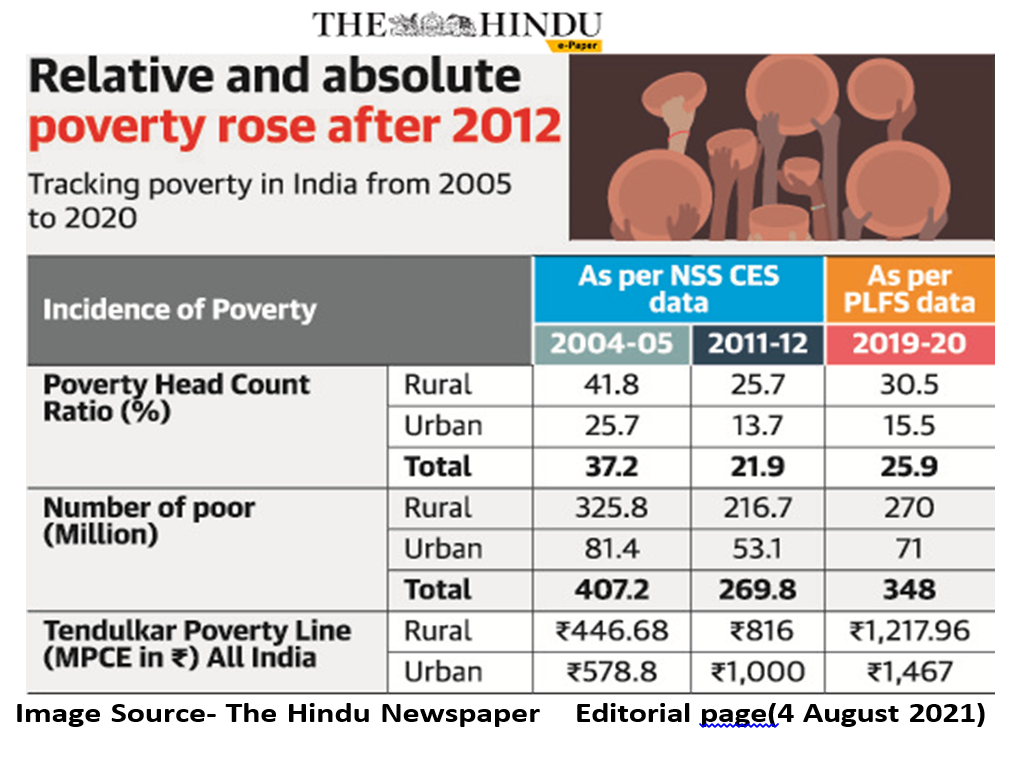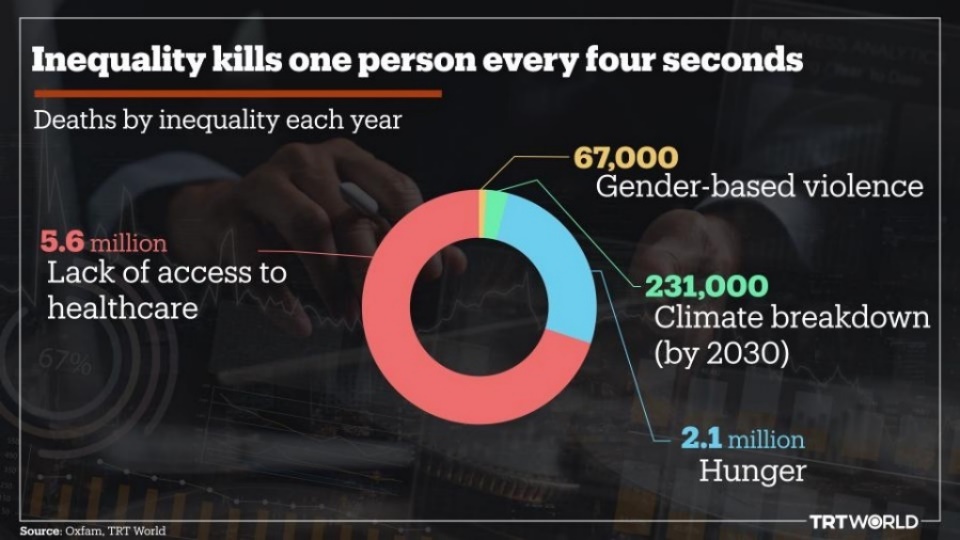Description

Copyright infringement not intended.
Context
- Surjit Bhalla’s latest paper Pandemic poverty and Inequality: Evidence from India has been published on the IMF website under the ‘IMF Working Paper’ section.
- This writer travelled to 30 villages in Odisha and Chhattisgarh in February to gauge the impact of food grain programmes on the level of poverty.
Findings of the paper
Food subsidies and Poverty
- Food subsidies under the National Food Security Act 2012 and the pandemic-specific relief programme, the Pradhan Mantri Garib Kalyan Yojana, have impacted extreme poverty and inequality level during the COVID-19 pandemic.
- Extreme poverty was as low as 0.8 per cent in the pre-pandemic year 2019, and food transfers were instrumental in ensuring that it remained at that low level in pandemic year 2020.
- Extreme poverty (less than Purchasing Power Parity $1.9 per person per day) in India is less than one per cent in 2019 and it remained at that level even during the pandemic year 2020.
- Extreme poverty in India was below or equal to one per cent in the last three years.
- Inequality — measured by Gini Coefficient — has reached its lowest level in 40 years, due to the food subsidies offered during the pandemic period.
|
Gini Coefficient
The Gini-coefficient is a statistical measure of inequality that describes how equal or unequal income or wealth is distributed among the population of a country. It was developed by the Italian statistician Corrado Gini in 1912. The coefficient ranges from 0 (or 0%) to 1 (or 100%), with 0 representing perfect equality and 1 representing perfect inequality. Values over 1 are theoretically possible due to negative income or wealth.
Read: https://www.iasgyan.in/blogs/important-economic-curves-for-upsc#
|
- For the first time in several decades extreme poverty in the world increased in the pandemic year 2020.
- India has not measured its poverty level for the last one decade. Usual household consumption expenditure surveys overestimate poverty rates as they don’t include the ‘in-kind’ benefits like the subsidised food grains under the above various programmes. Subsidised food grains invariably reduce people’s consumption expenditure according to the paper.
Moving on from this Paper let us now have a look at the state of Poverty in India in general.
State of Poverty in India: A general analysis
- Unemployment had reached a 45-year high in 2017-18, as revealed by NSO’s Periodic Labour Force Survey (PLFS).
- Two-thirds of people in India live in poverty:8% of the Indian population lives on less than $2 a day.
- Over 30% even have less than $1.25 per day available - they are considered extremely poor.
- This makes the Indian subcontinent one of the poorest countries in the world; women and children, the weakest members of Indian society, suffer most.
- India is the second most populous country after China with about 1.2 billion people and is the seventh largest country in the world with an area of 3,287,000 km².
- The highly contrasted country has enjoyed growth rates of up to 10% over many years and is one of the largest economies in the world, with a gross domestic product (GDP) of 1,644 billion US dollars.
- But only a small percentage of the Indian population has benefited from this impressive economic boom so far, as the majority of people in India are still living in abject poverty.

Copyright infringement not intended.
- According to a recently released Oxfam Report, income of 84 percent of households in the country declined in 2021.
- India is the third largest number of billionaires in the world after China and the United States, with more billionaires than France, Sweden and Switzerland combined.
- In 2021, the total wealth of 100 of India's wealthiest people reached a record high of Rs 57.3 Lakh Crore ($ 775 billion). In the same year, the bottom 50 percent of the population accounted for only 6 percent of national wealth. Oxfam described inequality as economic violence, adding that lack of access to health care, gender-based violence, hunger and climate change kill 21,000 people each day.
- According to data from the National Sample Survey (NSS) (201718), the out-of-pocket cost (OOPE) of private hospitals is about 6 times that of inpatient treatment in public hospitals and 2 to 3 times that of outpatient treatment. India's average OOPE is 62.67 percent, while the world average is 18.12 percent.

Copyright infringement not intended.
Reasons behind Poverty in India
- Illiteracy and lack of quality education: Despite more than 15 million graduates being produced every year, there are no jobs available for them due to lack of quality of education. Most of these graduates are studying outdated educational syllabus and hence cannot be productively employed anywhere.
- Vicious trap of poverty: Prevalence of massive malnourishment, stunting and wasting amongst children which negatively impact their physical and mental potential pushing them deeper into the vicious trap of poverty for the rest of their lives.
- Sub-standard health outcomes: More than 60% of the household incomes in many families is devoted towards health expenditure. This out of pocket expenditure on healthcare is one of the biggest pulling factor for poverty.
- Administrative Bottleneck: Certain government policies that favour one sector over the other. Also there is lack of rule of law and enforcement of laws such as the Minimum Wages Act.
- Income Inequality: According to the Oxfam, the top 10% of the Indian population holds 77% of the total national wealth. 73% of the wealth generated in 2017 went to the richest 1%, while 67 million Indians who comprise the poorest half of the population saw only a 1% increase in their wealth.
- Discrimination: Discrimination and poverty go hand in hand. Discrimination can both cause poverty and be a hurdle in alleviating poverty. Ex: Discrimination against women, SC, ST, Disabled, Old age people etc is one of the major causes of poverty among them.
- Nature of job: Approximately 56% of the total working population is in the agricultural sector. Which is marked by poor landholding, low productivity and disguised unemployment?
- The issue of low employment growth within industrial and service sectors has contributed to stagnant or declining standards of living.
- Inadequate public infrastructure: Lack of accessibility to primary health care centres, quality public schools, research institutions, roads, waterways, rural markets, etc. act complementary for the rise and sustenance of poverty in India.
- Poor policy structure: Given the vicious cycle of poverty, government hand-holding is needed to support those above poverty lines to prevent them from slipping below the line.
Consequences of Poverty
The high infant mortality
- 4 million children die each year in India before their fifth birthday.
- In addition to Nigeria, Pakistan, the Democratic Republic of the Congo and China, India is one of the countries with the highest child mortality rates.
- Pneumonia, malaria and diarrheal diseases as well as chronic malnutrition are the most frequent causes of death.
Malnutrition - not even a bowl of rice a day
- India is one of the world’s top countries when it comes to malnutrition: More than 200 million people don’t have sufficient access to food, including 61 million children. 7.8 million infants were found to have a birth weight of less than 2.5 kilograms - alarming figures for a country commonly referred to as the emerging market.
Child labour - no time to play and learn
- Although child labour for children under the age of 14 in India is prohibited by law, according to o cial figures, 12.5 million children between the ages of 5 and 14 are working.
- Aid agencies assume that in reality, there are many more estimating that 65 million children between 6 and 14 years do not go to school.
- Instead, in order to secure survival, it is believed that Indian children contribute to the livelihood of their families; they work in the field, in factories, in quarries, in private households and in prostitution.
Lack of education - no opportunities without education
- According to UNICEF, about 25% of children in India have no access to education.
- The number of children excluded from school is higher among girls than boys. Although women and men are treated equally under Indian law, girls and women, especially in the lower social caste, are considered inferior and are oppressed by their fathers, brothers and husbands.
- Without education, the chance of finding a living wage from employment in India is virtually hopeless.
Child marriage - the early end of childhood
- According to an investigation by the medical journal The Lancet, 44.5% of girls are still married in India before they are of legal age.
- Due to poverty, many parents encourage early marriages for their daughters in hopes of better lives for them.
Effects on Society
- The occurrence of violence and crime is geographically coincident. Due to unemployment and marginalization, poor people often indulge in wrong practices such as prostitution, theft, and criminal activities to earn money.
- Coupled with lack of education and properly formed moral conscience, a poverty ridden society is more affected to violence by its people against its own people from a sense of deep-seated discontent and rage.
- Homelessness affects child health, women safety and overall increase in criminal tendencies.Lack of money is a major cause of stress among the middle-class and the poor and leads to decline in productivity of individuals.
- Large families fail to meet the monetary needs of the members and children as young as 5 years are made to start earning in order to contribute to the family income.
- Terrorist organizations offer poverty-ridden families money in exchange for a member’s participation in their activities which induces a sense of accomplishment among the youth.
Effect on Economy
- Poverty is a direct index indicating success of the economy of the country. The number of people living under the poverty threshold indicates whether the economy is powerful enough to generate adequate jobs and comforts for its people. Schemes providing subsidies for the poor of the country again impose a drain on the economy.
Way Ahead
- Growth of population at the current rate should be checked by implementation of policies and awareness promoting birth control.
- All efforts should be made to increase the employment opportunities in the country, either by inviting more foreign investments or by encouraging self-employment schemes.
- Measures should be taken to bridge the immense gap that remains in distribution in wealth among different levels of the society. A 99% one off windfall tax on the wealth gains of the 10 wealthiest men in Covid19 alone will generate $ 812 billion.
- Certain Indian states are more poverty stricken than others like Odhisha and the North East states. Government should seek to encourage investment in these states by offering special concessions on taxes.
- Primary needs of people for attaining a satisfactory quality of life like food items, clean drinking water should be available more readily.
- Improvement of the Subsidy rates on commodities and Public Distribution system should be made.
- Free high school education and an increased number of functioning health centers should be provided by the government.
- At household level, the subsidized food grains have enabled people to meet food requirements but there is no certainty of income, particularly during pandemic time. But Poverty is not just a measure of hunger. There is a need for Universal Income Support. Economic Survey 2016-17 has suggested replacing all current cash transfers with universal basic income. The survey wants UBI to replace and not supplement the existing social welfare, anti-poverty schemes like MGNREGA, PMJSY etc.
- Investments in human capital and public goods have significant positive impacts on private-sector productivity, with estimated rates of return ranging from 15 percent to upwards of 45 percent. The enhanced productivity of human beings or human capital contributes substantially not only towards increasing labor productivity but also stimulates innovations and creates ability to absorb new technologies.
India has been tagged as a very consistent ‘developing nation’ and this difference between developing and developed will be achieved only when problems like poverty and hunger are eradicated.
https://www.thehindu.com/sci-tech/health/mumbai-confirms-omicrons-xe-recombinant-variant-union-health-ministry-denies-it/article65296308.ece

















